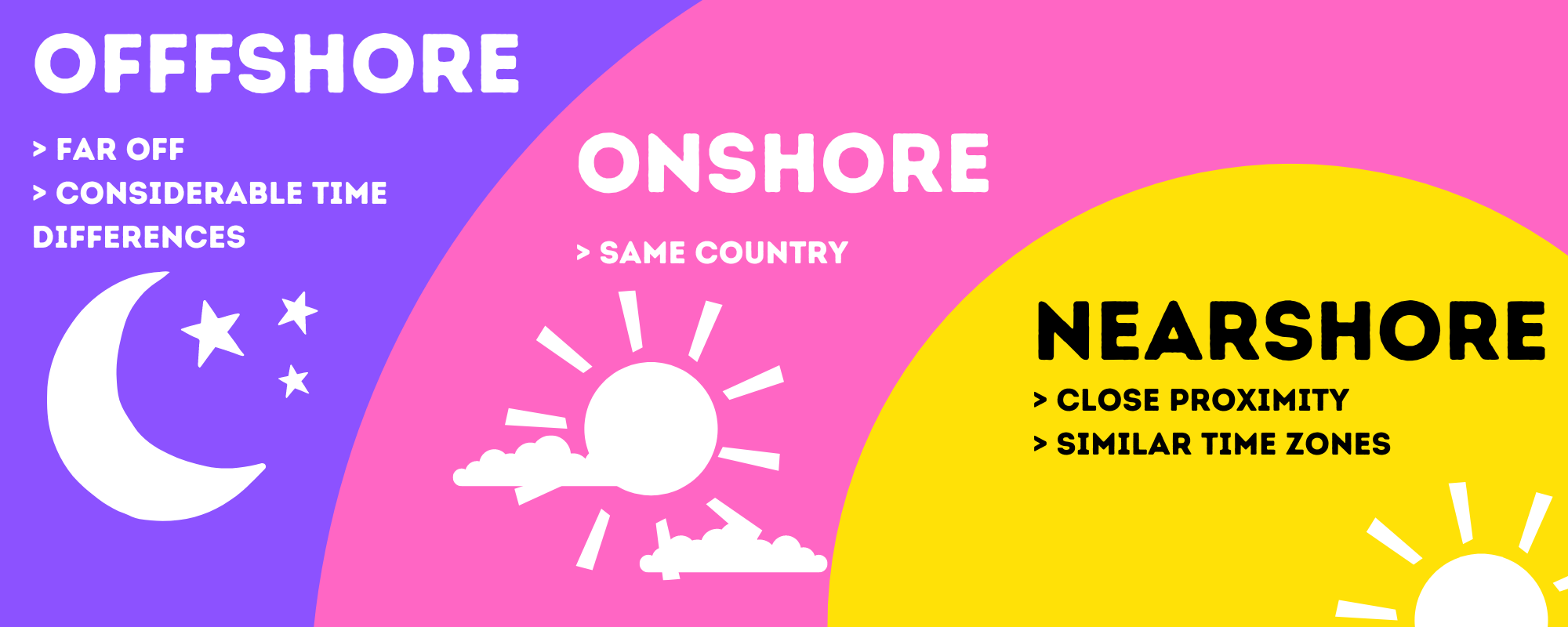
Understanding Outsourcing and Offshoring: Differences and Similarities
CATEGORIES
Tags
24/7 analytics australia automation Business Process Outsourcing company Copywriting CRM customer support data data and analytics Delegate digital digital advertising digital marketing Digital Support Staff ecommerce Email Management Email Marketing Entrepreneur Freelance Writers google ads graphic design Hiring Freelancers Marketing offshore offshoring ominchannel support organizer outsource Outsourcing Philippines Project management reporting seo seo audit Shopify Small Business social media Social media experts social media management United States video Virtual Assistant Virtual Team
Offshoring is always outsourcing — but not all outsourcing is offshore.
Outsourcing is when a company shifts its operations to a third-party service provider. While offshoring is outsourcing to a provider outside the company’s country of origin.
An example is when a Canadian company outsources software engineering to a firm also based in Canada, while they offshore customer support services to the Philippines.
Outsourcing and offshoring are business strategies that can happen one at a time or simultaneously.
But as a business, which is the best option for you?
Outsourcing and Offshoring

Outsourcing and offshoring are used synonymously but the two have different meanings and implications. Companies outsource and/or offshore to access expertise and reduce costs but they have a distinct definition, primary functions, project control, and advantages.
Below is a table to show their similarities and differences under different categories:
| Outsourcing | Similarities | Offshoring |
| Definition:
Delegating one or more business processes to a third-party service provider. |
Primary Functions:
Acquired for specific tasks or a complete role usually to increase efficiency or to cut costs. |
Definition:
Relocating one or more business processes to a service provider outside the company’s country of origin. |
Advantages:
|
Project Control:
As little or as much involvement as you need. The employees working on the tasks will not be the employees of the company |
Advantages:
|
Outsourcing and offshoring are mistakenly used as a term to describe one another. And some confuse offshoring with other terms like nearshore and onshore.

- Nearshore: outsourcing to service providers located nearby or with similar time zones. More expensive than offshore.
- Onshore: outsourcing to service providers located in the same country. No concerns regarding time zones, cultural differences, and proximity but can be availed at a higher cost than offshore.
- Offshore: outsourcing to service providers with considerable time zone differences. Lower costs in hundreds of countries to choose from with competitive digital markets.
Why offshore?

Cost-cutting is still one of the reasons why companies outsource offshore with 59% of business leaders choosing to shift their operations outside their company. 57% of the said businesses offshore to focus on their core operations. And 47% stated that offshoring solves their capacity issues.
When a company offshores it is helping two economies at the same time. In the Philippines, the BPO industry helped many citizens thrive and not just survive during the pandemic.
Large corporations like Amazon, American Express, Microsoft, and Google offshore to countries like the Philippines and India for increased efficiency. Knowing the benefits, from 80% in 2021, 90% of small businesses plan to outsource their business operations in 2022.
Benefits of offshoring

Companies have been compelled by the global economic downturn to look at every possible way to improve efficiency and reduce costs. As businesses realize they can outsource areas outside their core competencies, they are becoming more at ease with outsourcing and offshoring larger portions of their operations.
Offshoring minimizes the cost while ensuring quality: Companies are offshoring skilled and experienced teams equipped with advanced technology. And reputable service providers have their quality control to make sure that the work that you’re receiving exceeds your expectations.
Offshoring ensures business continuity: Offshoring is a business strategy to build a strong relationship with their offshoring partners. The trust and commitment you give to your offshored team can help you reach your objectives earlier.
Offshoring means flexibility and adaptability: Offshoring is a business strategy for fast and convenient market penetration with minimal tax obligations. You don’t have to apply for lengthy business fees and administrative processes.
Scale up and down as needed. During business expansion, peak season, and pressuring rapid growth, offshoring is a convenient solution for quick and effective scaling. This also means less business risk when laying off employees when demands fluctuate because you and your offshored team will only work until the contract ends.
Offshoring makes it easier to find niche talents: 75% of companies report talent shortages and difficulty in hiring. Outsourcing overseas talents fill this gap where companies can instantly access talent and resources. You can find your offshore service providers by a simple search online or by looking them up at talent marketplaces like Upwork.
Offshoring is a more cost-efficient solution to access advanced technology: Overseas service providers keep up with new technologies and upskills their team with new knowledge to cater to different clients. Some of the technology that companies can use to automate and simplify their operations and increase productivity include:
Robotic Process Automation Solutions: The RPA market value reached $1.89 billion in 2021 and industry experts projected its growth at 38.2% from 2022 to 2030. RPA is also expected to become more mature which will create a demand for intelligent automation.
AI, machine learning, and automation: The AI market revenue reached $93.5 billion in 2021 and industry experts projected its growth at 38.1% from 2022 to 2030. AI brought technology to the center of all operations by making data storage and recovery economically accessible.
Cloud computing: In 2021, cloud computing’s market value reached $368.97 billion and industry experts projected a 15.7% annual growth from 2022 to 2030. During the pandemic, there was an increased demand for cloud-based solutions. The overall resilience and security of the program improve the backend processes of the enterprises that use them.
Offshoring to improve customer experience: Companies acknowledge the importance of customer experience. Outsourcing to countries like the Philippines, Ukraine, and Poland which are popular destinations for customer service can improve your customer satisfaction with lower operational costs.
Offshoring for cybersecurity: In 2021, businesses suffered 50% more cyber attack attempts per week. Outsourcing cybersecurity is an efficient option than acquiring and managing a costly in-house cybersecurity team.
Offshoring significantly lowers overhead and operational costs. While there are also disadvantages, they are manageable.
Managing the disadvantages of offshoring

Culture and Social Differences: Communication issues can be easily minimized with a lot of English-speaking countries offshore but when you acquire a team with different cultural and social backgrounds, diversity means specific adjustments.
For example, a company from the United States wants to hire digital support services overseas. If they hire someone from India, there can be up to more or less than 16 public holidays depending on where they reside. When you add in the ten public holidays in the United States, there will be 26 holidays in the year that rarely coincide.
Different countries have different work ethics. In Japan, they have a popular envied concept of inemuri where workers can take quick naps during work hours. And some companies have a strict work-life balance where everything ends the moment the employee’s work off-hours strike.
Your service provider will take care of clarifying everything for you. This disadvantage can easily be managed by communicating with your offshored team about your expectations and what they can provide.
Time zone differences and proximity: With over 24 standard time zones globally not including zones with daylight savings and 30-45 minute offsets, an offshored team can be efficiently reached by communication and project management tools.
For example, the same company based in New York offshores to a Filipino service provider. The local time in the Philippines is 13 hours ahead of New York. To visualize the schedule, you can use a world clock. Again, according to what you agree on, your offshored team knows when to contact you.
You can take advantage of your offshored team working at the off-hours of your in-house team. Other service providers even have 24/7 availability which you can leverage for business growth.
There’s no limit in finding the suitable tools to use for milestone update and daily communication.
For instant conversations, you can use free tools like Slack, Emails, and video conferencing tools like Zoom, and Skype. The use of instant messaging applications is discouraged in business settings, because of its editable features.
For milestone updates, project management tools like Asana, Treelo, and ClickUp are the efficient tools for tracking and managing project tasks.
More than cost-cutting, 9 in 10 small businesses plan to outsource one or more business operations to increase efficiency and lower costs. And offshoring can help them reach the quality they envision at a fraction of the costs of outsourcing to developed countries.

